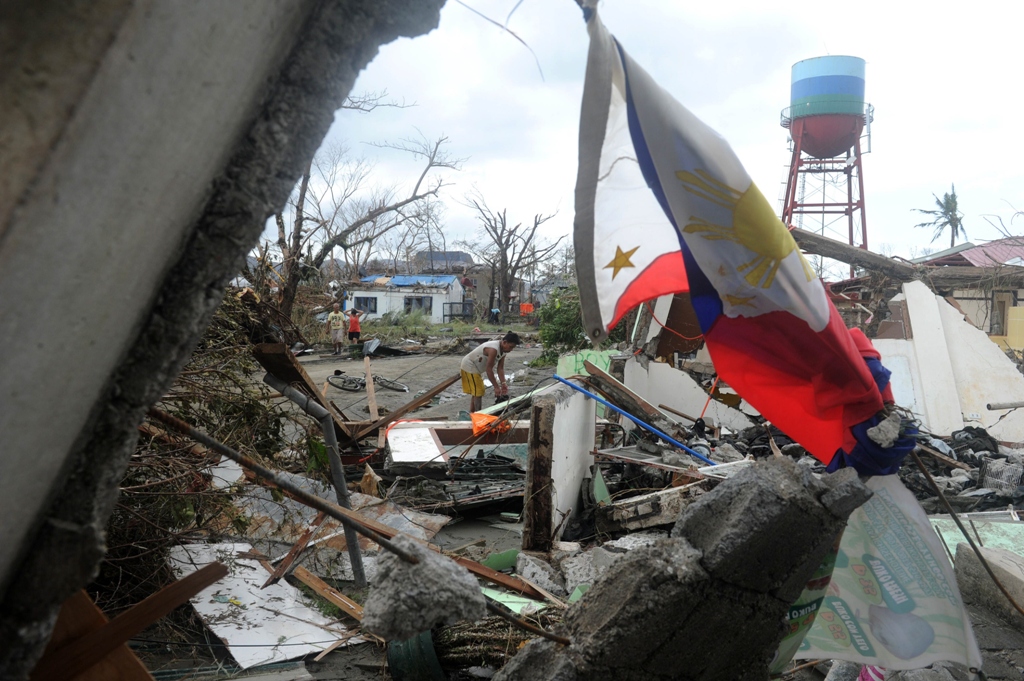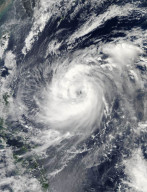
MANILA: More than 100 bodies were lying in the streets of a Philippine city smashed by Super Typhoon Haiyan, authorities said Saturday, as soldiers raced to reach many other devastated communities.
Haiyan tore into the eastern islands of Leyte and Samar on Friday with sustained winds of around 315 kilometres an hour, making it the strongest typhoon in the world this year and one of the most intense ever to make landfall.
Most of the worst-hit areas were cut off from communications throughout Friday, with power and telephone networks destroyed, and the first reports that began to emerge after daybreak on Saturday painted a deeply ominous picture.
In Tacloban, the capital of Leyte, the city's airport manager reported seeing more than 100 bodies littered around the facility, with at least 100 more people injured.
"The terminal, the tower, including communication equipment, were destroyed," Civil Aviation Authority of the Philippines deputy chief John Andrews told AFP, as he recounted the airport manager's assessment.
The military began flying C-130 planes full of relief supplies to Tacloban, which has a population of 220,000 people, on Saturday morning.
Andrews said the deaths were likely caused by huge waves whipped up by the typhoon, with the airport and surrounding areas lying alongside the coast.
A journalist for local television network GMA also reported seeing about 20 bodies piled up in a church in Palo, a coastal town about 10 kilometres south of Tacloban.
The initial reports from Tacloban and Palo raised fears of mass casualties, with Haiyan having devastated many other communities across the central Philippines that remained cut off from communications.
"We have reports of collapsed buildings, houses flattened to the ground, storm surges and landslides," Philippine Red Cross chief Gwendolyn Pang told AFP, giving an assessment across the whole region.
"But we don't know really, we can't say how bad the damage is... hopefully today we can get a better picture as to the effects of the super typhoon."
The government, military and Red Cross said one of their top priorities was trying to re-establish contact or reach communities in Leyte and Samar.
Fifteen thousand soldiers had been deployed to the disaster zones, military spokesman Lieutenant-Colonel Ramon Zagala told AFP.
"We are flying sorties to bring relief goods, materials and communication equipment," Zagala said.
He said helicopters were also flying rescuers into priority areas, while infantry units deployed across the affected areas were also proceeding on foot or in military trucks.
Haiyan swept across the central and southern Philippines throughout Friday before exiting into the South China Sea and tracking towards Vietnam.
More than four million people were affected across 36 provinces, the government said.
Another area of particular concern was Guiuan, a fishing town of about 40,000 people on Samar that was the first to be hit after Haiyan swept in from the Pacific Ocean. The Red Cross's Pang said contact had not yet been made with Guiuan.
Pang also expressed concern for people in the province of Capiz, about 200 kilometres west of Tacloban, on Panay island where she said most of the region's infrastructure had been destroyed and many houses "flattened to the ground".
At least three more people were killed in the far southwestern province of Palawan, ABS-CBN reported, citing a local disaster official.
Authorities expressed confidence on Friday that only a few people had been killed, citing two-days of intense preparation efforts led by President Benigno Aquino.
Nearly 800,000 people in vulnerable areas had been moved to evacuation centres, while thousands of boats across the archipelago were ordered to remain secured at ports. Hundreds of flights were also cancelled.
The government expressed alarm on Saturday about the unfolding scale of the disaster.
"We are very concerned about the situation there," Cabinet Secretary Rene Almendras told reporters, when asked about the deaths in and around Tacloban.
"The president is asking why there were still fatalities."
An average of 20 major storms or typhoons, many of them deadly, batter the Philippines each year.
The developing country is particularly vulnerable because it is often the first major landmass for the storms after they build over the Pacific Ocean.
The Philippines suffered the world's strongest storm of 2012, when Typhoon Bopha left about 2,000 people dead or missing on the southern island of Mindanao.


































































COMMENTS
Comments are moderated and generally will be posted if they are on-topic and not abusive.
For more information, please see our Comments FAQ